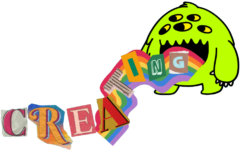Reversal method:
- Books open new worlds.
- Worlds open through books.
- Books offer endless adventures.
- Adventures provide great memories.
- Memories shape our lives.
Lateral Thinking – response
These ideas about suspending judgment and delaying evaluation feel very counterintuitive to how I’ve been taught to think. Throughout school, we’re constantly pushed to analyze things critically, poke holes in arguments, and discard anything that doesn’t seem airtight and logically coherent. The notion of intentionally entertaining and exploring ideas that seem outright wrong goes against everything I’ve learned about rigorous thinking.
At the same time, I can see the author’s point that this judgment-first mindset can easily shut down creative paths too early before they have a chance to lead somewhere unexpected. Groundbreaking ideas often do start from strange places. I think about how even some of history’s greatest thinkers had wacky theories that turned out to be Wrong but sparked insights that ultimately proved revolutionary. There’s wisdom in being willing to “go down the rabbit hole” with ideas, even seemingly ridiculous ones, just to see where they lead.
The examples about accidental discoveries happening precisely because people chose to pursue wrong assumptions are really compelling to me. It does make me question whether my default stance of quickly dismissing anything that doesn’t immediately make sense is stunting my creative potential. Maybe I’m cutting myself off from stumbling upon insights precisely because I’m unwilling to entertain approaches that seem off-base at first.
That said, I can also see problems with completely throwing out judgment and evaluation. It seems like a balance is needed – a willingness to be wrong temporarily while still maintaining some standard of eventual validity. After all, you can’t just believe any random nonsense indefinitely. But overall, I’m surprisingly persuaded that stepping outside my comfort zone of only logic-gating “right” ideas could unlock fertile new thinking. It’s an uncomfortable perspective shift, but one I may need to embrace if I want to reach my full creative potential.
Art & Fear – response
Wow, this really captures the constant self-doubt I feel when working on art projects. The idea that the vision in my head never quite matches the reality of what I create is so true and frustrating. I’m always scared the final piece will be a disappointment compared to what I imagined.
The point about materials having their own resistances also rings true. Whether it’s paint not behaving how I want, the clay being difficult to shape, or my expertise with a medium holding me back, the materials themselves provide challenges beyond just the concept. Overcoming those tends to be an unexpected struggle.
I can definitely relate to the underlying uncertainty about whether my work is any good or how it will be received. As much as I try to be confident, I can never fully shake the fear that others will think it’s bad or just not “get” what I was going for. That existential doubt plagues me constantly.
While it’s discouraging that these fears are inescapable, there’s also some comfort in knowing all artists face the same core uncertainties. At least I’m not alone in feeling this way! Recognizing these fears as inherent to the process rather than just personal failings could actually be weirdly motivating and empowering.
Thoughts on Ming Poon
Ming Poon is by far one of the most interesting artists I’ve encountered, and he’s quickly become my favorite. As I mentioned in class, I relate to him a lot. I love how he creates a safe space for his audience, where he simply presents his ideas and lets the audience take over. They become the show; they are the movement. It’s amazing how he gets people to connect and collaborate without even saying a word. His honesty in his work is really inspiring, and his views on death and life are so intriguing. It’s like he’s not afraid—he accepts fear and lets it go, just like he does with his art. This approach makes his work incredibly profound and moving.
